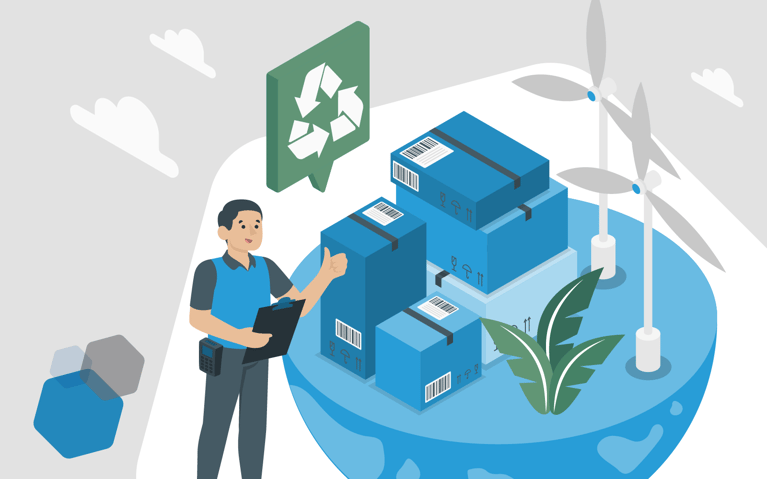As sustainability becomes increasingly important, so does the importance of creating environmentally-friendly products. While many businesses already focus on making their products better for the environment, they may be forgetting one key element: the sustainability of their packaging and shipping operation.
Almost 75% of consumers report that they would pay more for sustainably packaged products. By going the sustainable route, you'll not only stand out from competition and attract customers, you'll also find that investing in updates to your business' packaging and shipping procedures will save a lot of time and money.
Below is a breakdown of what exactly sustainable packaging and shipping are and how to implement them to see long-term benefits to your business.
What is sustainable packaging and shipping?
Sustainable packaging is less damaging to the environment compared to traditional packaging materials like virgin plastics, which have never gone through recycling facilities (i.e., packaging that is made from reusable, recyclable, or plant-based materials).
Similarly, sustainable shipping cuts down on the use of fossil fuels and other environmentally-damaging practices. Standard shipping methods have several direct negative environmental impacts, including air pollution, oil pollution and carbon emissions.
Using sustainable packaging and shipping can improve your brand image, bring down shipping costs, and increase sales for your company, in addition to reducing your carbon footprint. It will likely bring in more customers as well.
The initial investment to updating your shipping and packing practices may seem steep at first, it will be worth it in the long run.
How to implement an eco-friendly packaging solution
There are several ways to implement an eco-friendly packaging solution. Consider the following recommendations:
Update your packaging procedures
Companies often set their packaging procedures when they first start selling products and never update them again. That’s a mistake.
As your business grows and changes, you should periodically check to see whether there are any updates you should make to your packaging procedures. Ask yourself these questions to get started:
- Are there any parts of your packaging procedure that can be automated?
- Is it time to change your packaging design or packing materials?
- Do you have clear guidelines in place for each step of the packing process?
- Could you be more strategic with your warehouse layout?
- Are you using the best packages for your products (e.g. boxes, padded mailers, envelopes)?
With the recent innovation in the packaging industry, there are many sustainable options available such as those that use water-soluble materials and 3D printing technology.
If using a pick-pack-ship system, optimize your packing efficiency by switching to a different pick method like piece picking or zone picking.
Use the correct packaging size
When you send your customers their orders in packages that are too large, you're wasting packaging materials and space on your delivery trucks. Instead, try to ship orders in the smallest packaging size that will still keep the items inside safe and secure.
If your company often has to pack products in packages that are too large, consider purchasing more package options. It’s important to have several standard packaging options that work well for your most popular products. This will save you money in the long run.
The cost savings potential of choosing the correct packaging sizes may surprise you. By reducing the packaging size on a single sofa, IKEA was able to save over a million dollars every year. Unused space in your packages means money wasted on infill and packaging materials. Making small changes to the packaging sizes is a great way to optimize your shipping costs.
Try to think outside the box when brainstorming ways to reduce your use of packaging materials. For example, Allbirds found a way to use flexible packaging to ship shoes in just one box (rather than a shoe box within a larger shipping box) and cut their packaging material consumption by 40%.
Use recycled materials for packaging and filling
Why use new packaging materials that can't be recycled when there are plenty of recycled sustainable packaging materials available?
Using packaging made (at least partly) of recycled plastic or other recycled raw materials will always be more sustainable than new packaging materials. Encourage your customers to also reuse the packaging from your products. Ideally, your product packaging will continue to be used for something else.
Recycled cardboard and paper are commonly available if you want to start using recycled packaging. You can also find recycled plastic material, though this is less common.
Novelty packaging design that uses many different materials and components may help your products stand out, but it’s not the most sustainable option. Instead, look for innovative materials that cut down on waste as much as possible. If it can work for your product, consider something like edible packaging. Even if your customers don't actually consume the packaging, food waste is less harmful to the environment than plastic, which takes hundreds of years to decompose.
Your packaging company may be able to offer advice on how to incorporate more recycled materials into your current packaging. There are also companies specifically dedicated to sustainable shipping and packaging, like Notpla, which makes fully biodegradable food packaging, and Cellulotech, which creates plastic-free packaging with 100% renewable mono-material.
Ship similar orders together
Consolidating orders into fewer shipping boxes will lower your shipping costs and make your packaging more sustainable. When shipping similar orders together, you can reduce the packaging materials and (sometimes) the fuel required to deliver packages to your customers.
For example, say a customer orders several different items from your e-commerce store and another customer who lives nearby also places an order. A more sustainable and affordable shipping method would involve packaging the two customers’ orders in one box each, then shipping the two boxes together on the same shipment for delivery.
Limit the number of returns
Returns are something every e-commerce store has to deal with. The average return rate for online purchases in 2021 was a whopping 20.8% — up from 18.1% the previous year.
Every time one of your customers returns a product, that return leads to additional packaging and shipping. It means more time wasted, more fuel burned, and more overall waste.
While eliminating returns entirely may not be feasible, any of the following can limit the amount of returns you receive:
- Short your return window (e.g. from 90 days after purchase to only 30 or 60 days post-purchase)
- Provide high-quality, clear product images and descriptions so that customers receive exactly what they expected to
- Offer excellent customer service to resolve any problems customers have with their orders before returning them
- Work with an expert in fulfillment services to reduce the odds that your customers end up with the wrong products
- Survey customers about why they returned their items and make adjustments accordingly
- Identify and combat “serial returners” who return a high volume of orders
Implementing even one of the above solutions can drastically lower your overall return rate. which will, in turn, lead to more overall sustainability in your business.
Invest in thermally printed label makers
While traditional shipping labels are printed with ink, that there’s a more eco-friendly alternative.
Thermally printed labels use head to create images or text, don't require ink and produce much less non-recyclable waste compared to traditional printed labels.
Although purchasing thermally printed label makers for your business is an investment of anywhere from $1,000 to $4,000, it will eventually pay off, given the already high and rising price of ink. .
Consider sharing these sustainability practices on your products' labels - customers will appreciate the story and effort around reducing environmental impact.
Tips for creating a "green" shipping process
Making your shipping process "green" is just as important as implementing a sustainable packaging solution. Below are some tips for shipping your products in an eco-friendly way:
Reduce your carbon footprint with zero-emission vehicles
One of the greatest sustainability concerns when it comes to shipping products is greenhouse gas emissions. Every medium-sized package delivery generates about eight pounds of carbon emissions, on average. Instead, consider using zero-emission vehicles to make deliveries.
As their name suggests, these vehicles do not produce harmful emissions that can hurt the environment, like carbon dioxide, hydrocarbons, heavy metals and particulates.
Some examples of zero-emission vehicles include electric cars, human-powered transportation like bicycles and carriages, and electric trains. Even if you can only add just one zero-emission vehicle to your delivery fleet, it will reduce your company’s carbon footprint significantly. Don't forget to advertise your company’s commitment to cutting down emissions in this way so that your customers (and potential customers) are aware of your sustainability efforts.
Optimize your delivery routes
If your delivery drivers drive all over town only to end up right next door to one of their earlier deliveries, there’s a problem with your delivery routes. Each unnecessary mile that your drivers travel is consuming extra fuel and contributes to unnecessary carbon emissions. Optimizing your delivery routes is the sustainable solution.
An easy mistake to make when optimizing delivery routes for your company is trying to figure it all out on your own. It's difficult to create truly optimized routes by hand, but software and machine learning can do it seamlessly.
Route optimization software takes all of the places each driver needs to go and finds the shortest route. Optimized routes not only reduce fuel usage and carbon emissions, but will also lead to faster and cheaper deliveries.
Ensure your shipping provider is environmentally-friendly
Once you hand off your sustainable products to your shipping provider, you'll want to make sure that they also incorporate sustainability efforts into their practices.
Ask your current or potential shipping provider questions like:
- What eco-friendly transportation solutions does your company implement?
- How do you measure your business's commitment to sustainability?
- Do you practice carbon-neutral shipping?
- Which shipping methods do you use (road, air, rail, and/or sea freight) and why?
Visiting a shipping provider’s website should give you a good sense of their sustainability efforts, but it’s always smart to open up a dialogue about sustainability with them, too. The shipping provider you choose will impact your company’s supply chain image. If your shipping provider isn’t environmentally-friendly, your company’s other sustainability efforts may ring hollow.
Turn to a complete packaging and shipping solution
Tackling all these steps can be intimidating, but you don’t have to reinvent the wheel to implement sustainable packaging and shipping into your business. You can choose to go slowly — step by step to make parts of your shipping and packaging processes more eco-friendly — but that can be time-consuming and costly.
So, why not turn to the experts?
With the help of an experienced packaging and shipping provider, making your company more sustainable is easy. Cart.com's packaging and shipping solutions take care of everything you need to make your business a more eco-friendly one. Reach out today to get started.





